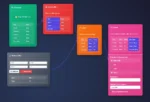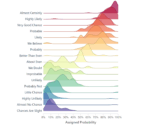Decision-makers are continually tasked with deriving deeper insights from increasingly complex data streams.
While traditional analytics often focus purely on standard numeric datasets, modern competitive organizations understand the strategic value of integrating multi-modal sensory analytics – leveraging audio, visual, and text data formats together for richer insights and in-depth decision-making.
This emerging frontier delivers more precise outcomes, enabling organizations to respond faster, innovate confidently, and remain agile amidst relentless market shifts.
To help leaders navigate this evolving landscape, we’ll provide clarity on the value and strategic implementation of multi-modal analytics and illustrate why cross-domain unified analytics represents the future of business intelligence.
Understanding Multi-Modal Analytics: The What and the Why?
The term “multi-modal analytics” may sound complex, but its premise is surprisingly intuitive. This practice entails blending diverse data modalities—specifically audio, visual, and textual streams—into comprehensive, unified analyses to create richer insights and more informed decisions. For example, combining speech audio analysis from customer service calls along with customer review texts and video feedback can offer deeper emotional context, sentiment analysis, and nuanced insights unattainable by traditional analytics relying solely on structured numerical data.
Why diversify data inputs? Simple—human experiences and interactions reflect themselves through multiple sensory channels simultaneously. Leveraging this phenomenon drives significantly richer customer understanding, product improvement opportunities, brand sentiment analysis, and market trend forecasts. Implementing advanced multi-modal analytics enables firms to move beyond limited isolated analyses and develop holistic capabilities. From customer experience analytics in retail to portfolio optimization in financial sectors, the inclusion of audio and visual cues alongside text analysis—combined seamlessly via modern software capabilities and innovative data methodologies—results in sharper business intelligence, strategic clarity, and greater competitive edge.
Core Benefits of Integrating Sensory Data Streams
1. Richer Contextual Insights
Human communication relies heavily on signals beyond mere vocabulary text—music, voice tone, facial expressions, and gestures illuminate richer meanings beneath surface-level interactions. Combining audio and visual analytics, such as vocal sentiment detection or video emotion recognition, alongside traditional text analysis creates complete insight portraits. For instance, integrating customer call audio analysis with textual transcripts offers powerful clues into customer frustration or satisfaction that purely textual transcripts may overlook, improving customer service optimization outcomes.
2. Faster, More Accurate Decision-Making
Speed and accuracy directly influence competitive advantage. Certain market scenarios, such as financial trading or crisis event detection, demand rapid analytical judgment calls. Leveraging integrated visual, audio, and textual analyses rapidly pinpoints emerging trends, opportunities, or risk signals. Aligning disparate data sources harmonizes analyses quicker. To facilitate this, advanced firms embrace modern data engineering capabilities, much like we outline in our blog discussing the importance of CI/CD pipelines, to streamline modifications and deployments of multi-modal analytic solutions that deliver quicker insights and greatly enhance performance.
3. Better Customer and Market Understanding
Enterprises consistently strive toward deep customer and market insights. Conventional numeric measures alone often fall short, but multi-modal analytics generate effective strategic understandings. By analyzing visual, textual, and audio-based customer reactions together, businesses gain granular behavioral insights. Consider e-commerce—combining product review sentiments (text analytics) with customer support calls (audio tone detection) and unboxing video sentiment (visual analysis) significantly strengthens customer-centric strategies. This level of insight enhances product improvements, optimizes engagement, and identifies subtle customer experience upsides often missed in traditional isolated data approaches.
Technical Considerations: Challenges & Strategic Approaches
Even as comprehensive multi-modal analytics promise strategic transformation, challenges persist around data ingestion, compatibility, storage capabilities, reliability, and potential schema conflicts. Different formats and schemas across audio, visual, and textual datasets require sophisticated techniques such as polymorphic schema handling in data lakes, ensuring your ingestion architecture flexibly accommodates diverse sources and supports future growth without sacrificing robustness.
Enterprises must also embrace semantic analytics in cross-discipline analyses, moving beyond basic keyword approaches to capture nuanced meanings. Innovation in semantic technology—such as those detailed in our guide on semantic embeddings for business intelligence—promises powerful approaches for accurately interpreting human-generated unstructured data streams across audio, visual, and written formats, driving better analyses and deeper business intelligence.
Strategically, adopting effective pipeline designs becomes critical to efficiently move, transform, and analyze multi-modal data. Choosing between traditional approaches like ETL (Extract, Transform, Load) or more flexible modern methodologies like ELT (Extract, Load, Transform) depends upon your data strategy and internal infrastructure, a topic explored comprehensively in our article comparing ETL vs. ELT approaches. Organizations prioritize technical partnerships and consulting services in data to confidently navigate this complexity and deliver high-performance outcomes rapidly.
Implementing Multi-Modal Analytics: Practical Steps for Your Organization
Evaluate Organizational Readiness
Begin your journey toward fully integrated sensory analytics by accurately assessing readiness regarding data capabilities, infrastructure, technical talent, and budget availability. For organizations facing financial constraints, consider practical cost-saving methods documented in our article on setting up modern data stacks economically. This evaluation phase determines gaps and identifies your specific investment roadmap, shaping your strategic analytics direction clearly.
Define Clearly Aligned Objectives
Organizations often overlook well-defined, aligned multi-modal analytics objectives, wasting resources on inefficient exploratory experimentation. Instead, align sensory analytics objectives clearly with specific business goals—customer sentiment, product experience, or risk management, among others. Leveraging frameworks addressed in our detailed breakdown of domain-driven data design enables organizations to isolate and prioritize relevant requirements clearly, resulting in effective outcomes and strong strategic impact.
Ensure Data Quality & Governance
Data integrity and governance in analytics become critically important in multi-modal use cases, largely due to complexity and source variety. Deploying proven data quality testing frameworks—such as those discussed in our comprehensive comparison of data testing methodologies—ensures accurate, robust analytical insights. Consistent quality assurance across audio, visual, and text sources minimizes risks, improves decision accuracy, and fosters stakeholder confidence in the long-term integrity of sensory analytics.
Avoiding Pitfalls and Common Mistakes in Multi-Modal Analytics Implementations
Despite significant advancements, new adopters discover common pitfalls. Typical errors, such as siloed modality-specific approaches or reliance on inadequate or overly complex tools, often undermine the effectiveness of combined sensory approaches. One should cautiously approach the solution landscape and pay attention to established industry advice—such as our insights into the most overrated tools in data engineering—to avoid expensive missteps and wasteful distractions.
Startups and established enterprises alike regularly face specific data implementation challenges. Our research on the top data mistakes prominent among startups provides key lessons relevant across all enterprise maturation stages, ensuring organizations adopt multi-modal analytics strategically, responsibly, and effectively.
Furthermore, ensuring analytical outputs drive impactful insights requires the practical understanding of different visualization types. For sensory data integration, continually reference our expert guide examining data visualization types, ensuring visual simplification and clear presentation amplify analytical advantages effortlessly for stakeholders.
The Evolving Frontier of Sensory Analytics
Multi-modal analytics represent the convergence of technical innovation, strategic opportunity, and integrated data intelligence. Organizations mastering sensory analytics will secure a substantial competitive edge by revealing hidden customer insights and gaining better market understanding. Strategic adoption ensures agile analytics, flexible innovation, informed strategic decision-making, and practical business advantage.
As decision-makers, embracing integrated multi-modal sensory data unlocks richer insights—propelling organizations toward future success. The sensory analytics renaissance is here—lead proactively.



















